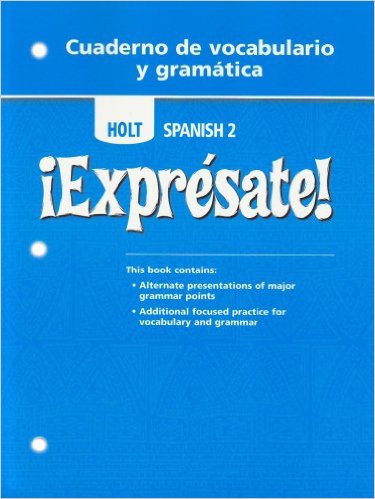
All Solutions
Page 25: Vocabulario
2. f
3. e
4. b
5. c
6. a
7. g
2. a
3. b
4. a
5. a
My dad needs to buy oranges at the fruit store (“la frutería“).
2) mercado
3) peluquería
4) tienda de comestibles
5) mueblería
6) plaza
We must complete the sentences with consistent information.
|Spanish |English |
|–|–|
|¡Hola, mamá! Hoy fui al centro con mi hermana. | Hi mom! Today I went downtown with my sister.|
|¡Hola, mamá! Hoy tuve que recorrer el centro para hacer algunas cosas. |Hi mom! Today I had to go downtown to do some things. |
|Spanish |English |
|–|–|
| *Pues, primero* fui a la peluquería a cortarme el pelo y luego al banco a sacar dinero. | *Well first* I went to the hair salon to cut my hair and then to the bank to get money. |
|*Pues, primero* fui a la pastelería para comprar un pastel de cumpleaños para una amiga. | *Well first* I went to the pastry shop to buy a birthday cake for a friend.|
|Spanish |English |
|–|–|
|*Sí, y allí* compre algunos dulces para compartir. |*Yes, and there* I bought some candies to share. |
|*Sí, y allí* compré los ingredientes para hacer una pizza. |*Yes, and there* I bought the ingredients to make a pizza. |
| Spanish| English|
|–|–|
|*Estuve en la panadería y allí* compré pan y jugo para esta noche. | *I was in the bakery and there* I bought bread and juice for tonight.|
| *Estuve en la panadería y allí* compre pan para comer con la pizza.| *I was in the bakery and there* I bought bread to eat with the pizza.|
| Spanish| English|
|–|–|
| *No, no fui al ayuntamiento porque* no tenía suficiente efectivo. | *No, I did not go to town hall because* I did not have enough cash.|
| *No, no fui al ayuntamiento porque* olvidé mi identificación en casa. |*No, I did not go to the town hall because* I forgot my identification at home. |
|Spanish |English |
|–|–|
| *Porque no encontré* los teléfonos públicos.| *Because I couldn’t find* the public phones.|

